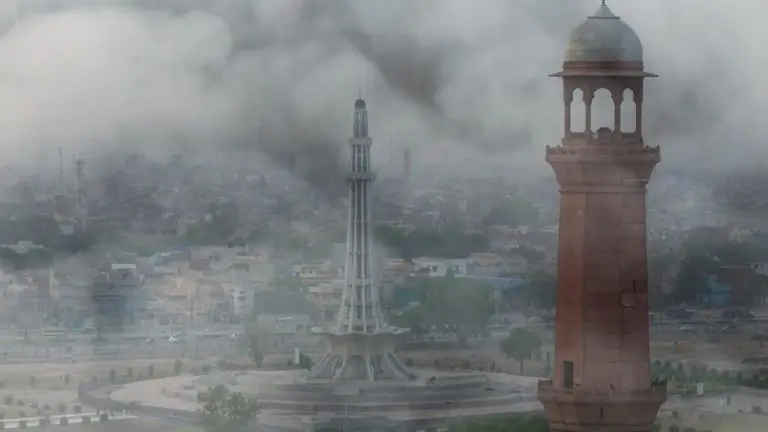Winter visits to Lahore were always a source of adventure for me—a stroll down memory lane. The weather was invariably delightful! During the hours of apricity, wandering through Anarkali Bazaar, alive with groups of women and vocal shopkeepers, was a pleasurable experience. Sampling tangy, delectable traditional cuisines at Lahore’s food street is another mouth-watering memory. However, as several years slipped away in the blink of an eye, I recall our plans often getting canceled. It all became hazy: the motorway and my plans. The air pollution in Lahore has placed all these heavenly memories in cold storage. Now, as I grab the crisp newspaper every day with a dim hope of catching the bright side, I observe the smog crisis in Lahore making headlines.
The once-vibrant and bustling historical city of Lahore is now shrouded in smog. The climate crisis continues to deflate Pakistan’s development balloon, as evident in Lahore’s current situation. Lahorites live in a bubble of smog, disrupting the daily rhythm of life, causing unwanted delays, and thickening the layer of uncertainty. Data has shown that air pollution in Lahore has peaked in recent years, leading to numerous issues. Recently, Lahore has consistently ranked No. 1 on the list of the most polluted cities globally. Moreover, the freshly measured AQI level of Lahore falls within the “unhealthy” category, reaching a dangerous number of 470, and nowadays, the value ranges between 200 and 300. The lethal particulate matter, PM2.5, in Lahore is 52.5 times the WHO annual air quality guideline value at the time of writing.
The escalating crisis captured my attention, prompting me to delve deep into research. Experts identify pre-winter crop residue burning as a significant contributor. Stubble burning generates tones of breath-killing gases, including carbon dioxide (CO2), nitrogen dioxide (NO2), and sulphur dioxide (SO2). These components contribute to acid rain, a hazardous phenomenon of climate change. Furthermore, I discovered that vehicle emissions account for 43% of the smog, according to an article published by ‘Profit Pakistan Today’. Another report states that 40% of the 7 million vehicles in Lahore contribute to the smog. Additionally, toxic gases emitted from industries, coal-powered production plants, local factories, brick kilns, and other factors contribute to the dense, impenetrable layer of smog.
Stubble burning, vehicle emissions, and industrial pollution weave a toxic tapestry, suffocating Lahore in a deadly smog prison.
It dawned on me that the first target of smog is health. According to AQI, air pollution could reduce life expectancy by seven years. Eye allergies, respiratory infections, and asthma problems are on the rise. Lahore is home to top-notch brands and an educational hub for students. Schools remained closed for four days, disrupting academic activities. Upon reopening, mask-wearing became mandatory, and shutters in the markets, alongside restaurants, also remained down.
On a travel note, intercity motorways like M11 and M2, connecting Lahore to the rest of Pakistan, are closed due to the looming fear of a higher accident rate. According to a recent report by DAWN newspaper, two people have died and 16 sustained injuries in a fog-related accident. Visibility levels also decrease, leading to delayed or canceled flight operations. The illicit practices of industrial units have drawn the government’s ire, leading authorities to launch a strict crackdown to check for air purifiers and monitors. All efforts are ongoing to reduce the AQI level. It is a state of emergency, and authorities are earnestly devoted to mitigating smog. Lahore has fallen into a lockdown phase: wearing masks, minimal social activities, and health danger.
I find myself floating between sorrow and cherishing moments. While I am surprised at how quickly I have leapt out of childhood, and Lahore will still keep magnetizing me with its unique ambiance, I lament the current situation of Pakistan’s second-largest city. Connecting the dots in the above discussion places a bundle of blame on the smog crisis. Yet, an element is missing. Our response always remains overdue until a calamity knocks on the door. For example, Lahore Air Data 2022 was already lamenting, but the efforts to sanitize the city of smog effects were nothing to write home about. At the beginning of 2023, smog troubled millions of lives, and as we bid farewell to the year, the situation has gone from bad to worse. The same is true for other departments.
Schools shut, flights delayed, masks mandatory – Lahore’s daily rhythm is disrupted in a symphony of smog-induced chaos.
Whether it’s the economy, education, or any other sector, we keep our eyes closed until we get trapped in the abyss. We do not work to keep things smooth. Instead, alarming facts and reports wake us up, and we work to mend things. Our belief is to fix things rather than save the system from corrosion. We always work only when we stand on the brink of calamity. And put in a state of hassle, we find ‘temporary’ solutions that may drag us out of trouble. How can we expect better luck next time, then?
The cycle perpetuates. While we refrain from hard work and dedication, gradual destruction continues behind the scenes, and eventually, a great giant is ready to engulf us. We hardly learn lessons from our failures. All we manage to do is play a blame game and offer soothing statements. However, actions speak louder than words. A long-term, permanent solution only comes from consistent work. Let us step out of the political bubble. The problem is that we realize it’s time to respond. Our call to action is always overdue. Isn’t it?

Appreciate this article!